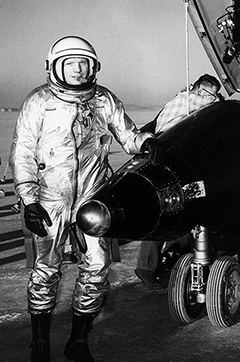February 26, 2016
Did You Know?: Pre-astronauts
 |
|
NASA test pilot Neil Armstrong is seen here next to the X-15 ship #1 after a research flight. (Photo courtesy of NASA Armstrong Flight Research Center) |
Amid all the famous Purdue graduates stand three alumni who became pre-astronauts before Project Mercury, the NASA program that put the first American astronauts in space.
Malcolm Ross grew up in West Lafayette and graduated from Purdue in 1941 with a physics degree. As a student, he had an interest in radio and worked at the campus radio station as a sports announcer. He became a news and sports reporter in Indianapolis right out of college, then joined the Navy in 1943. In the Navy, he served as a meteorologist at Pearl Harbor and aboard the aircraft carrier USS Saratoga. His work with meteorology acquainted him with balloons, a concept of taking an aluminum gondola into the edge of space. By 1961, Ross had become the world's most experienced stratospheric balloonist. On May 4, 1961, he took Strato-Lab V up to a peak altitude of 113,740 feet.
The two other pre-astronauts, Iven "Kinch" Kincheloe and Neil Armstrong, trained to be test pilots -- a flier who takes new and experimental aircraft up to see firsthand how well it works.
Kincheloe grew up in Cassopolis, Michigan, and then graduated in 1949 with a bachelor's degree in aeronautical engineering. While at Purdue, he developed an interest in being a test pilot. Upon graduation, he went on to train on jet aircraft for the Air Force and flew combat missions in the Korean War. In 1953 he went to the Empire Test Pilot School in Farnborough, England. Kincheloe became a test pilot at Edwards Air Force Base, where he tested the X-2, reaching a maximum height of 126,200 feet. Due to breaking the 100,000 feet barrier, he was referred to as "Mr. Space" and was on top of the list in 1958 for being chosen for the astronaut program. Kincheloe died on July 26, 1958, while testing a Lockheed F-104.
Armstrong grew up in Wapakoneta, Ohio, and received his bachelor's degree in aeronautical engineering in 1955. Before going back to school to receive his master's in aerospace engineering from the University of Southern California, he flew jet fighters in the Korean War. After receiving his master's degree, he became a test pilot for NASA and was actively engaged in the piloting and engineering of the X-15 program. Armstrong flew the X-15 seven times between Nov. 30, 1960, and July 26, 1962, with a peak altitude of 207,500 feet.
Sources: "The Pre-Astronauts: Manned Ballooning on the Threshold of Space" by Craig Ryan; "Wings of Their Dreams" by John Norberg; NASA Armstrong Flight Research Center
Writer: Aspen Deno, denoa@purdue.edu

